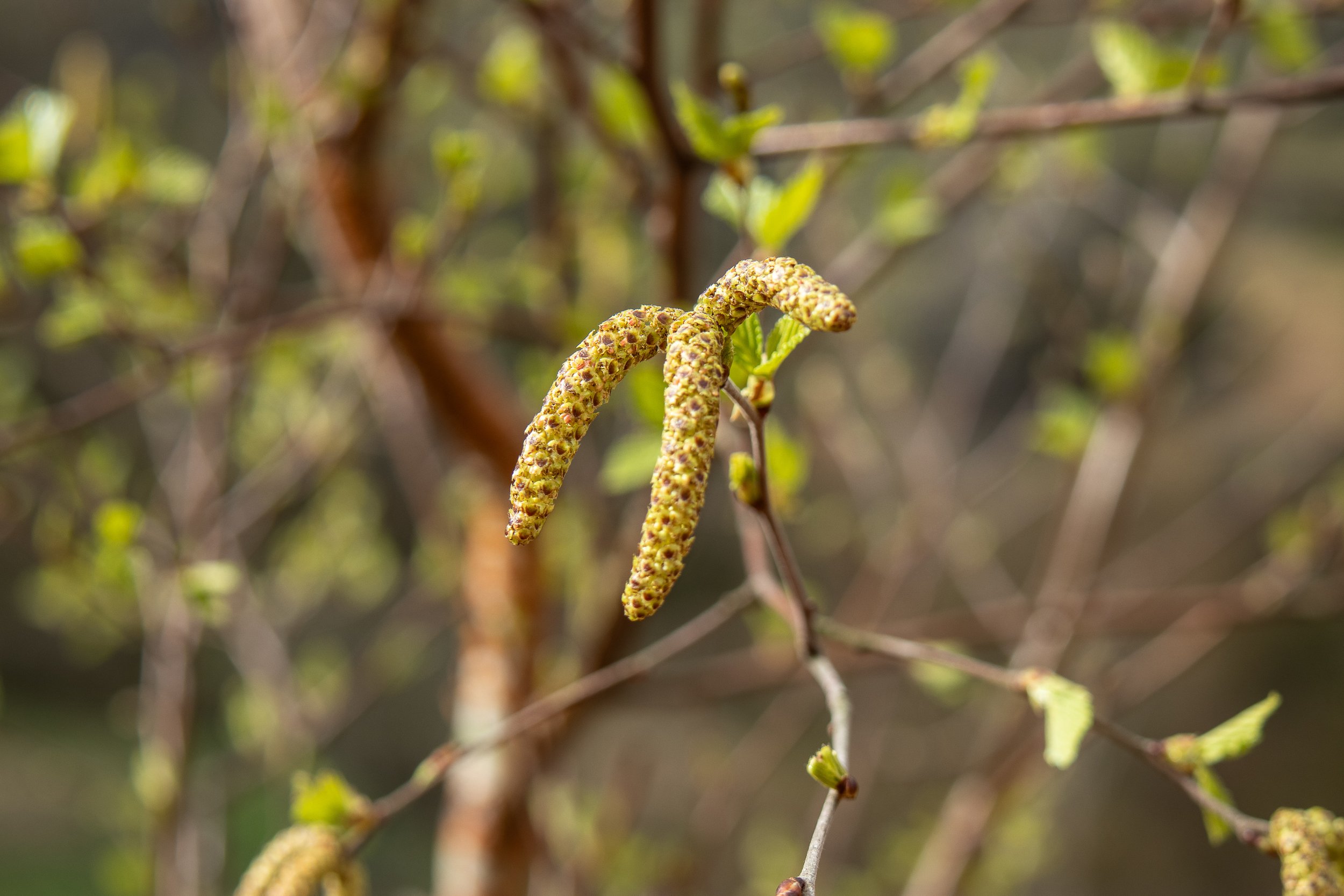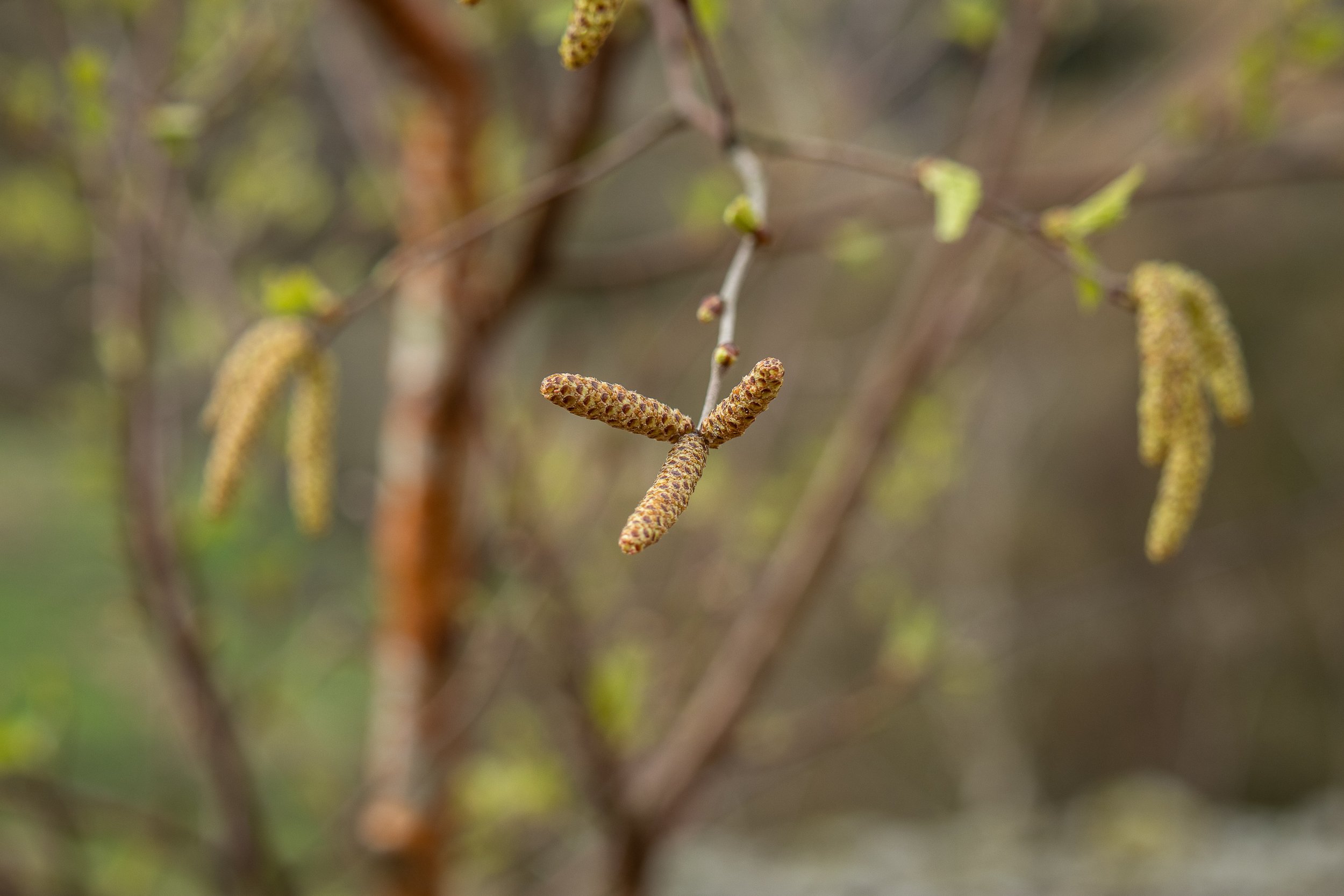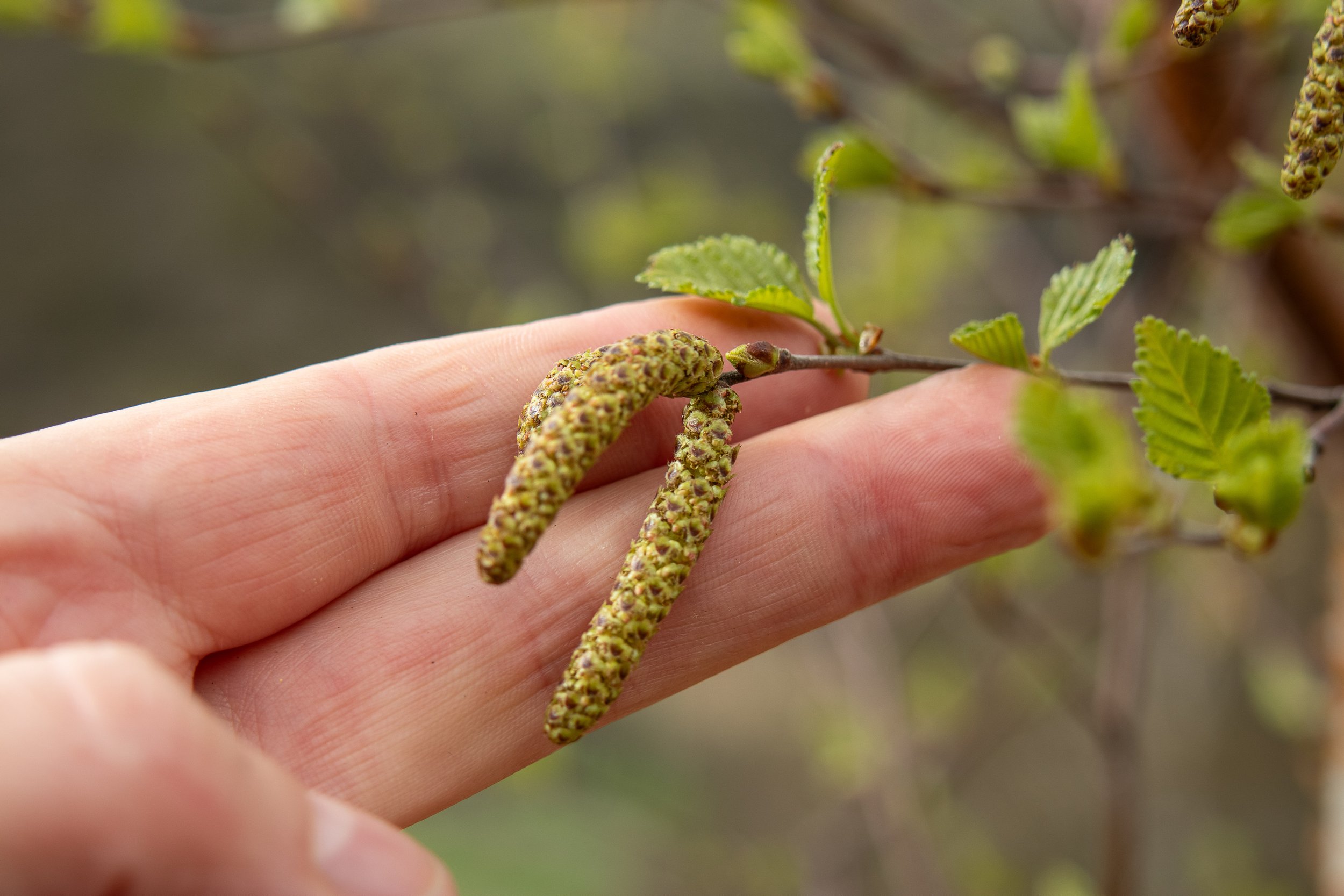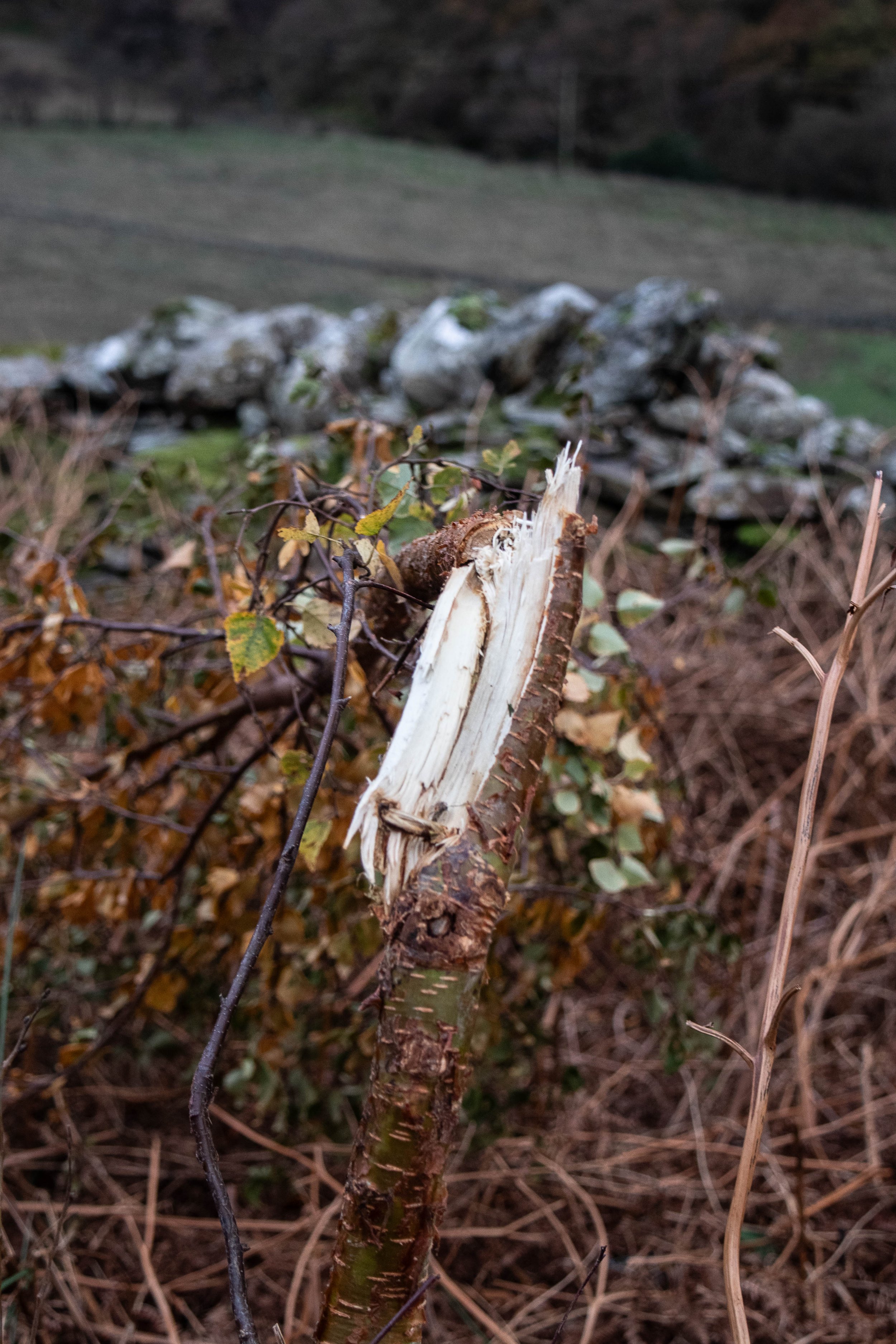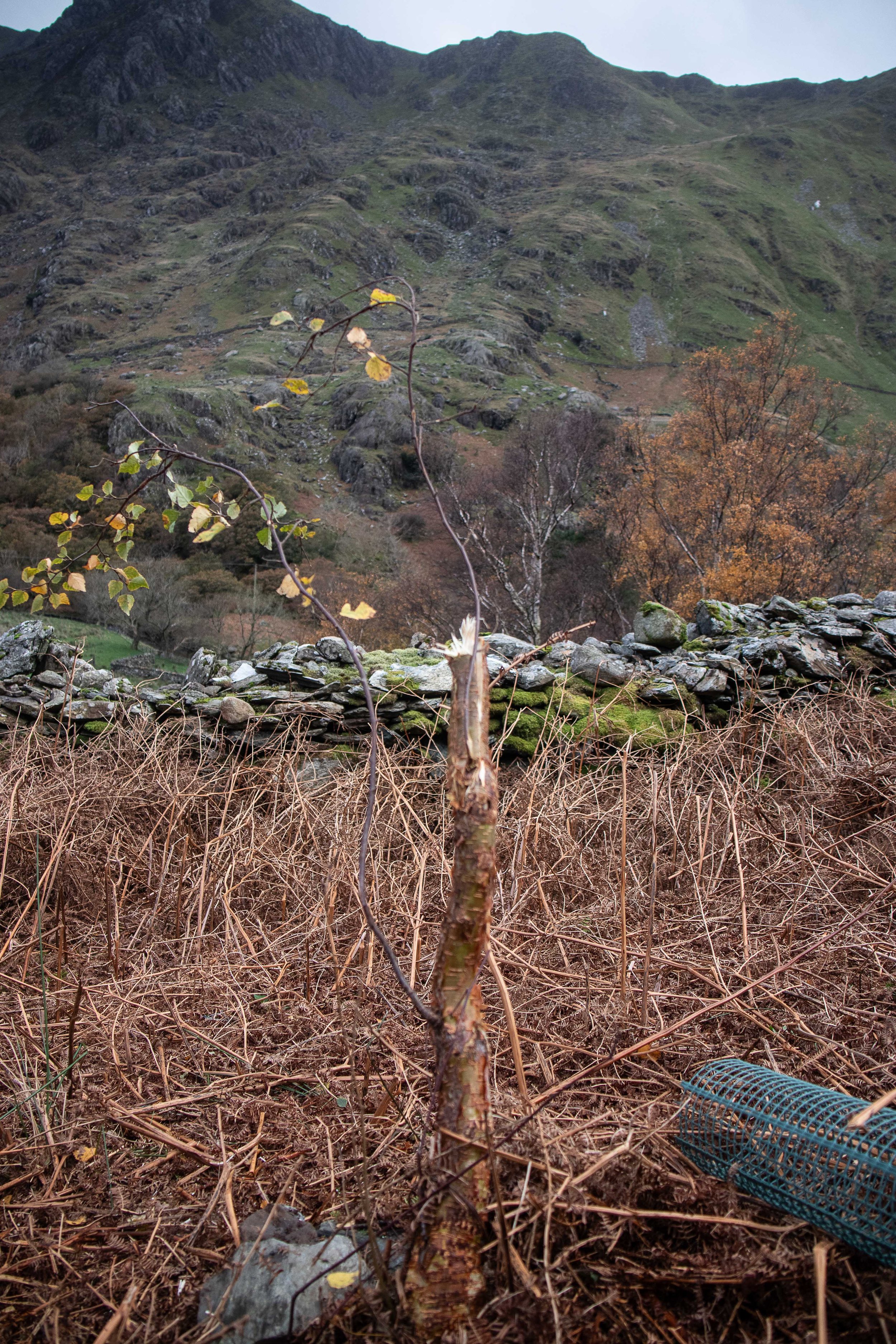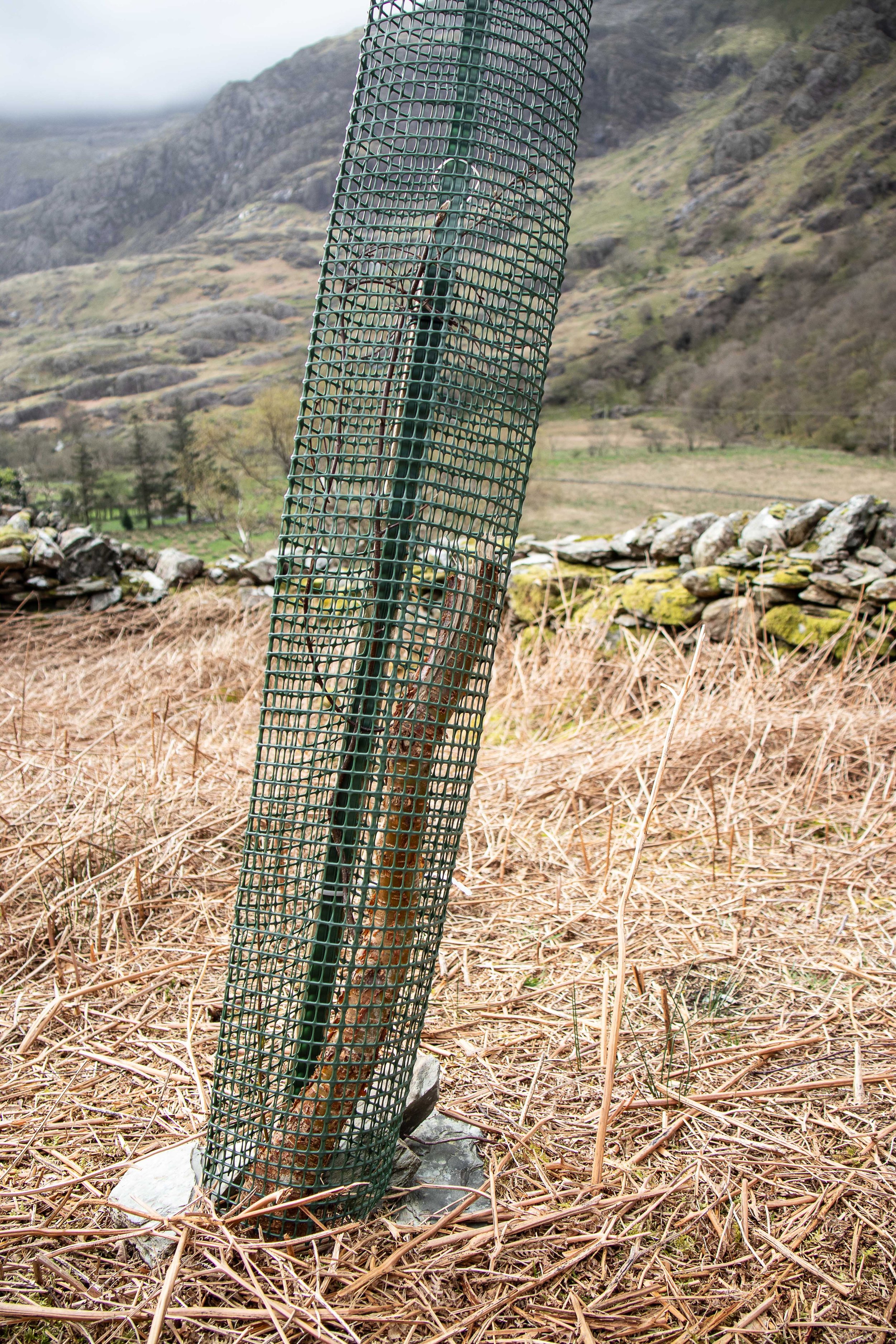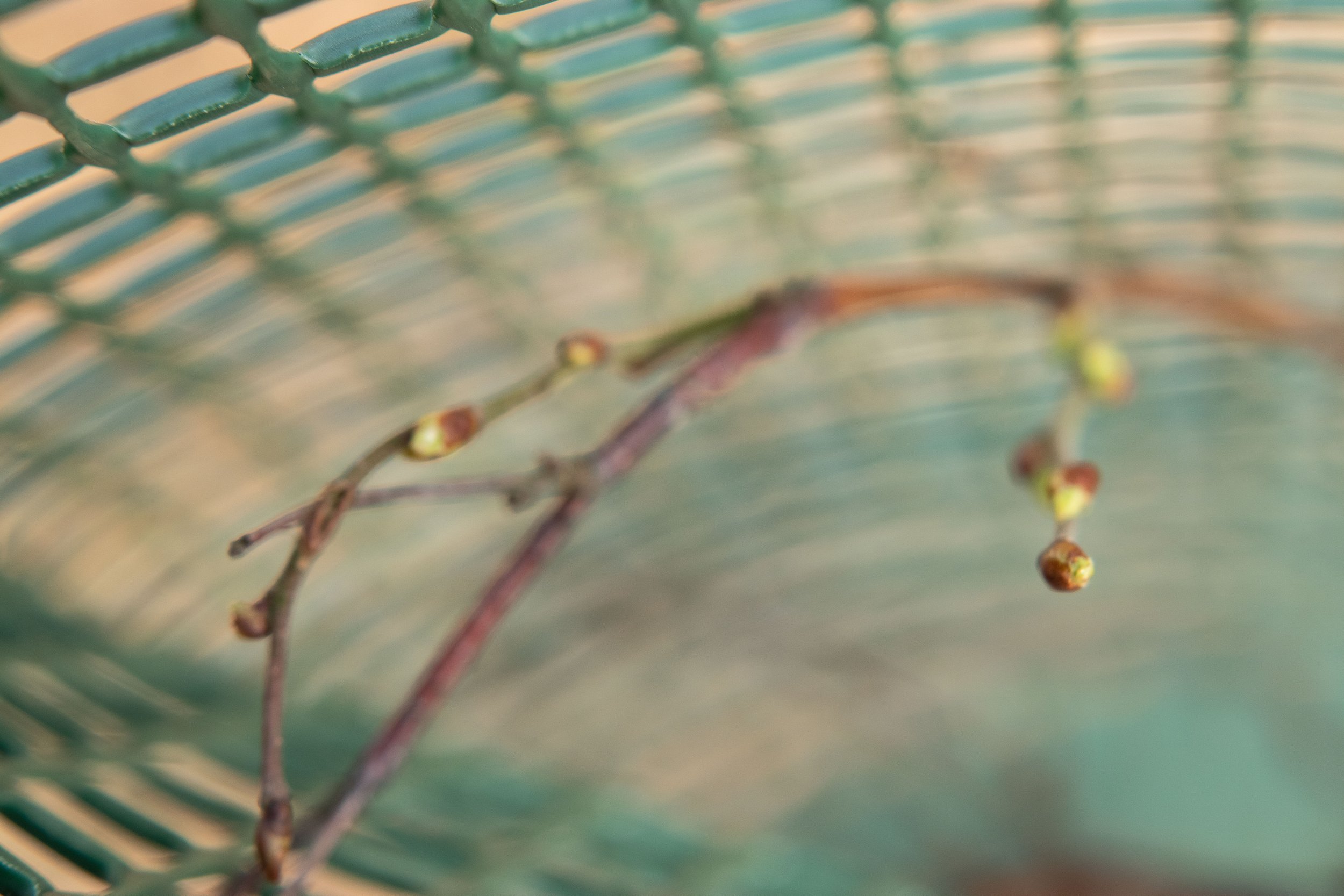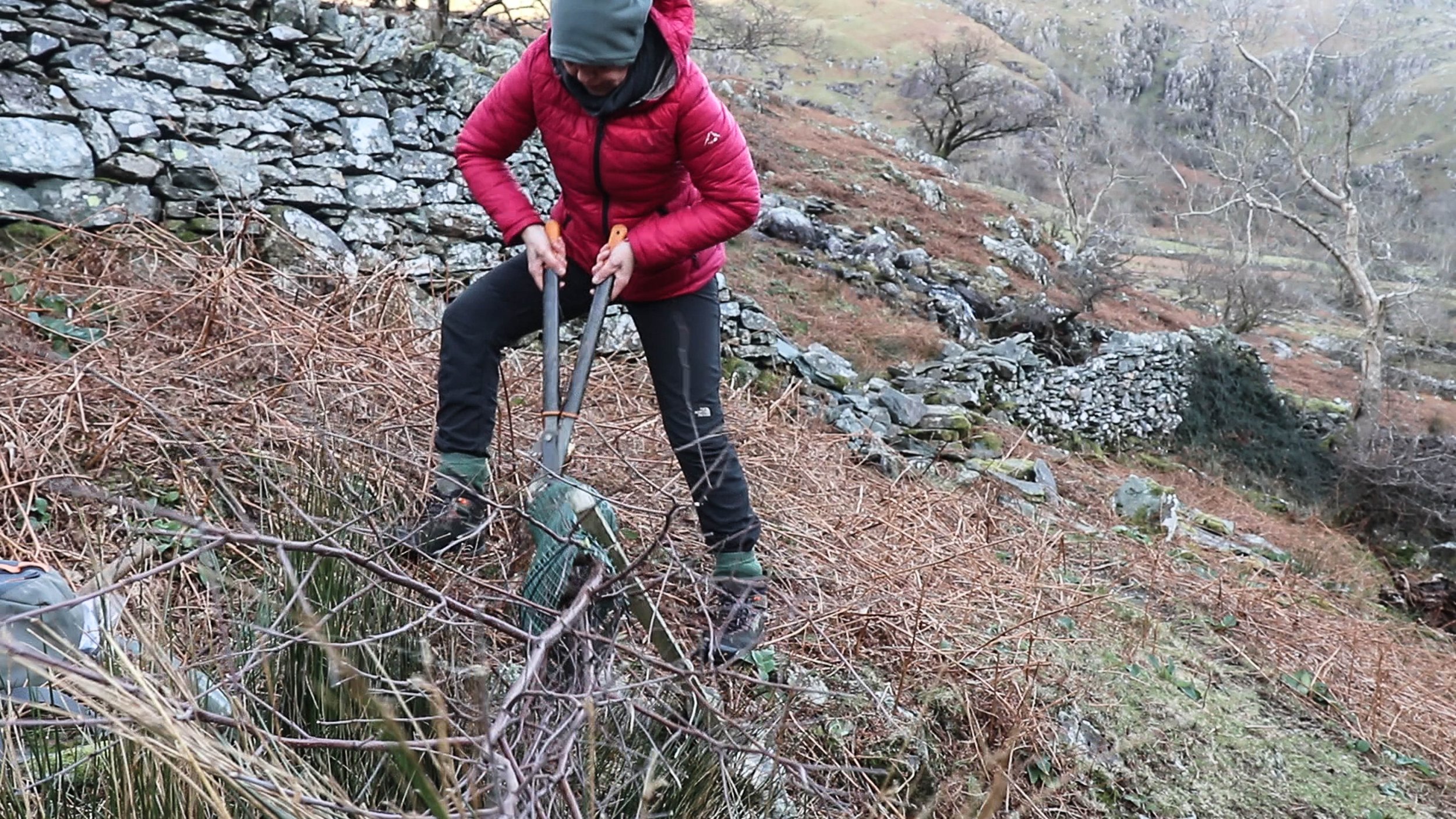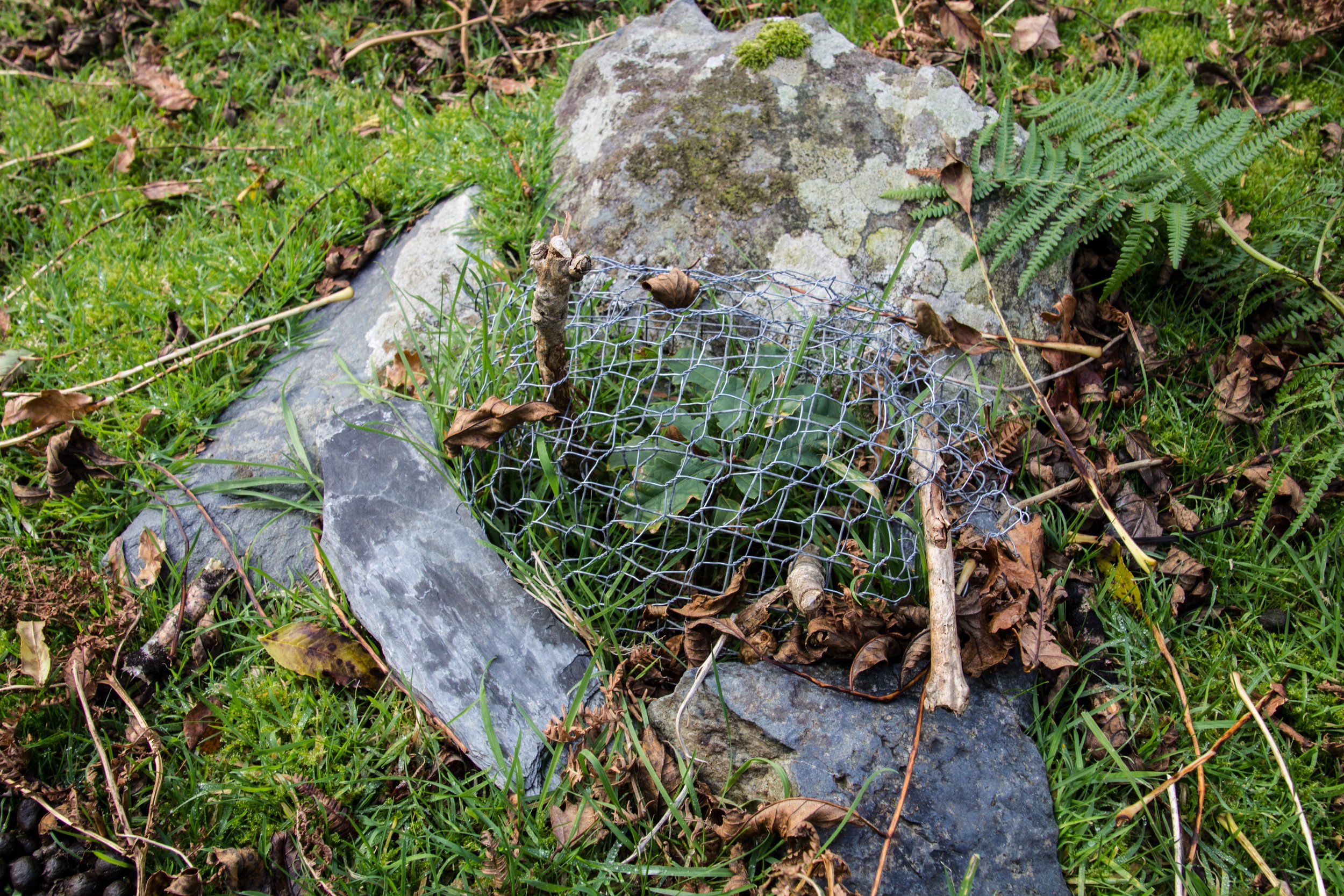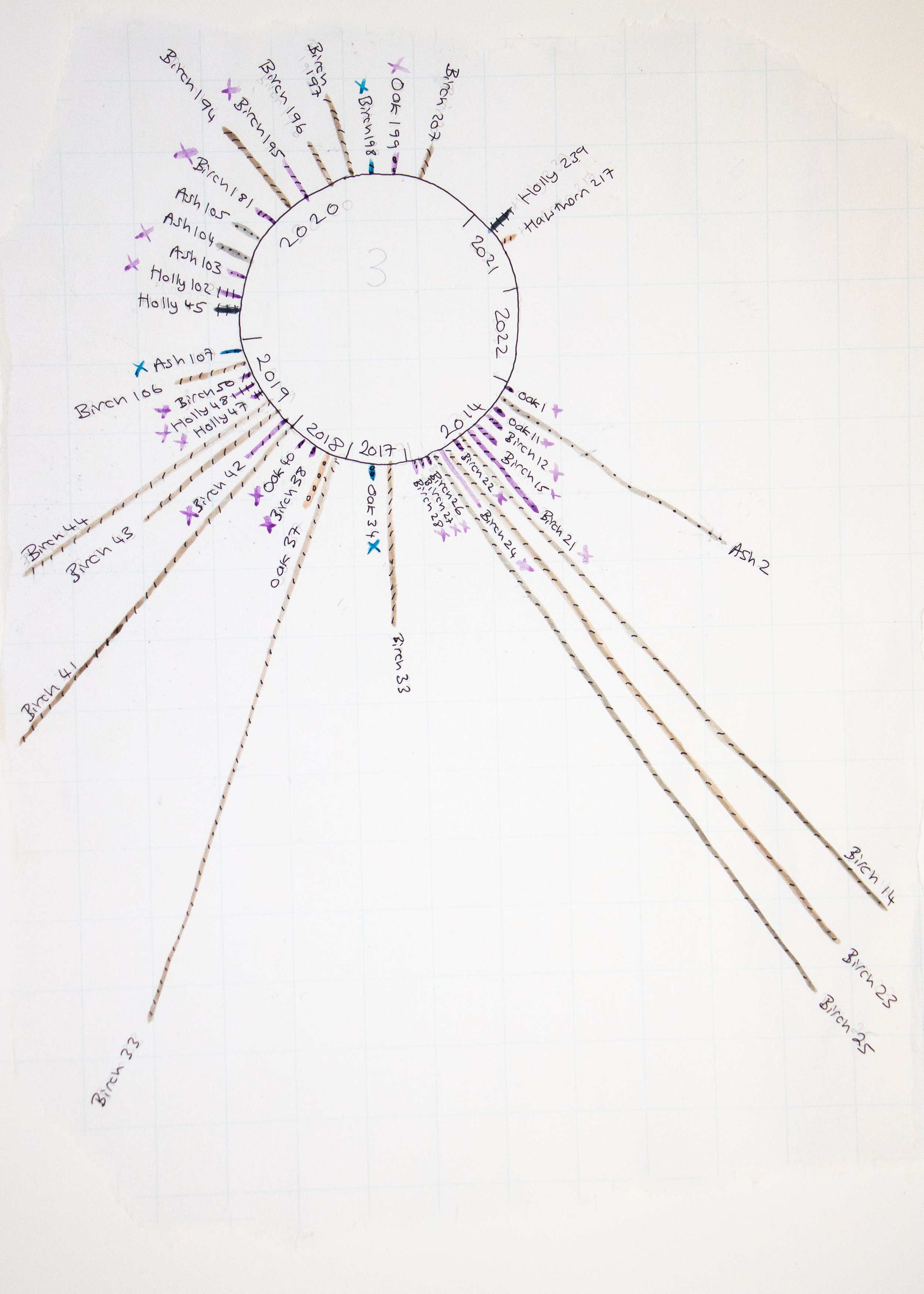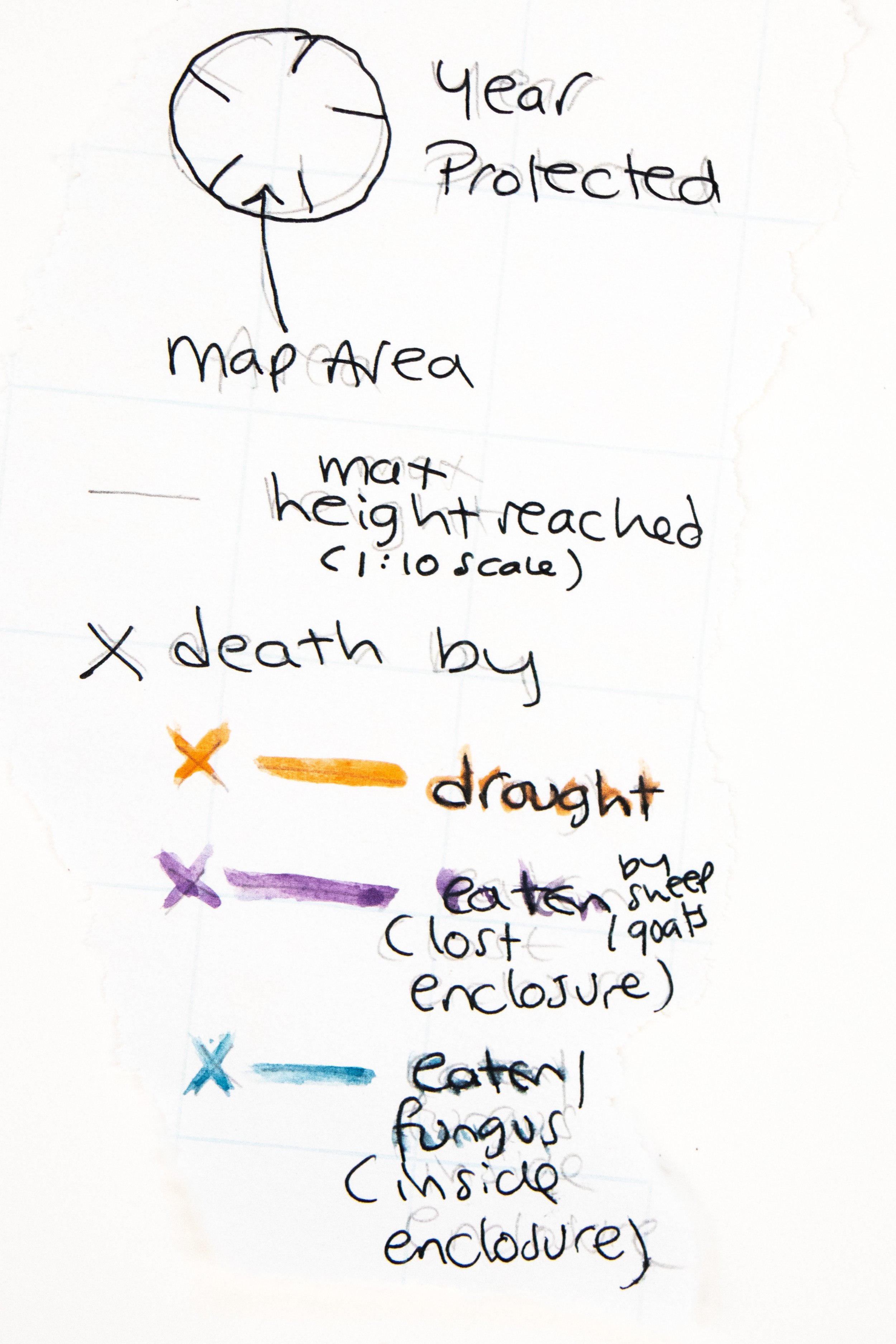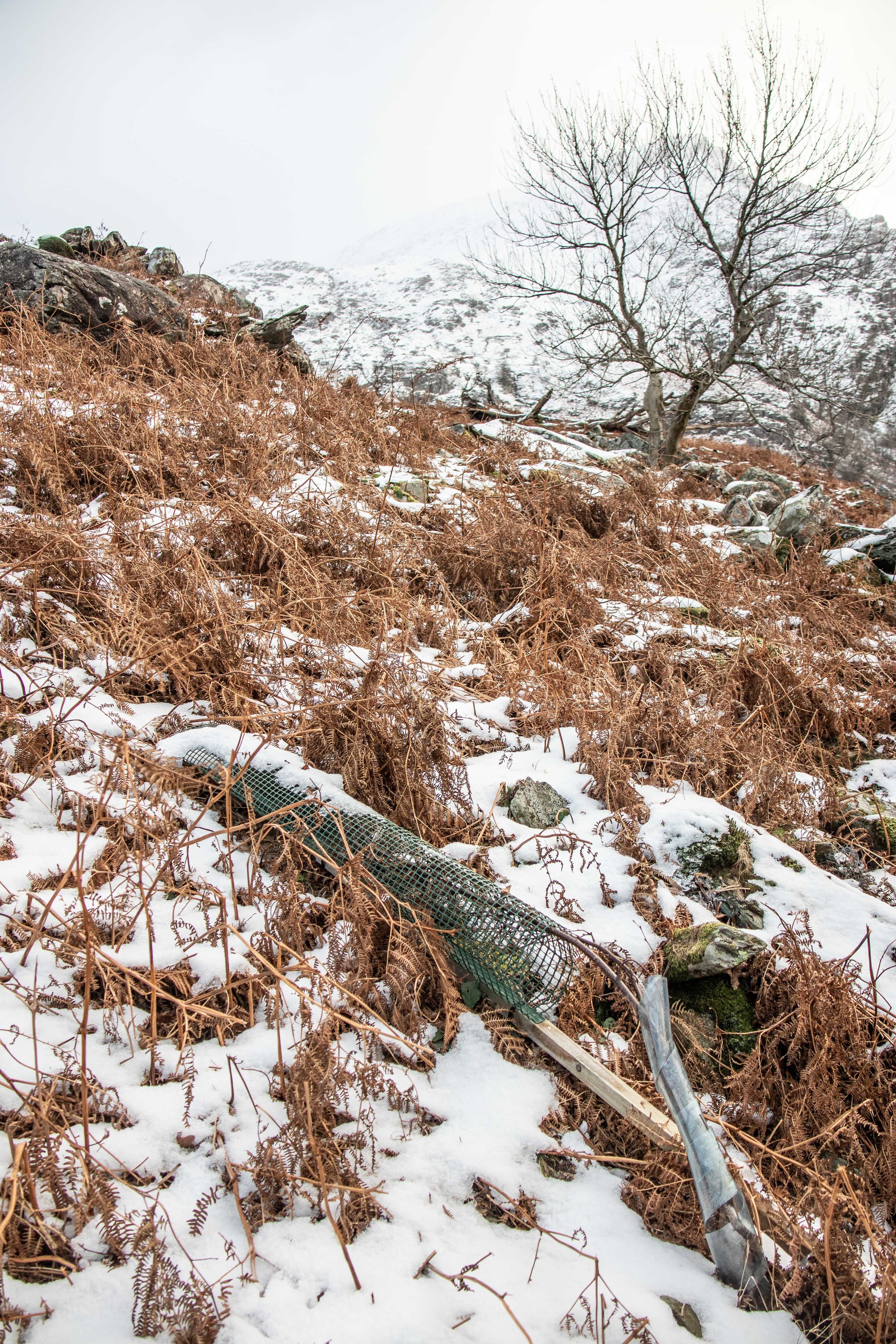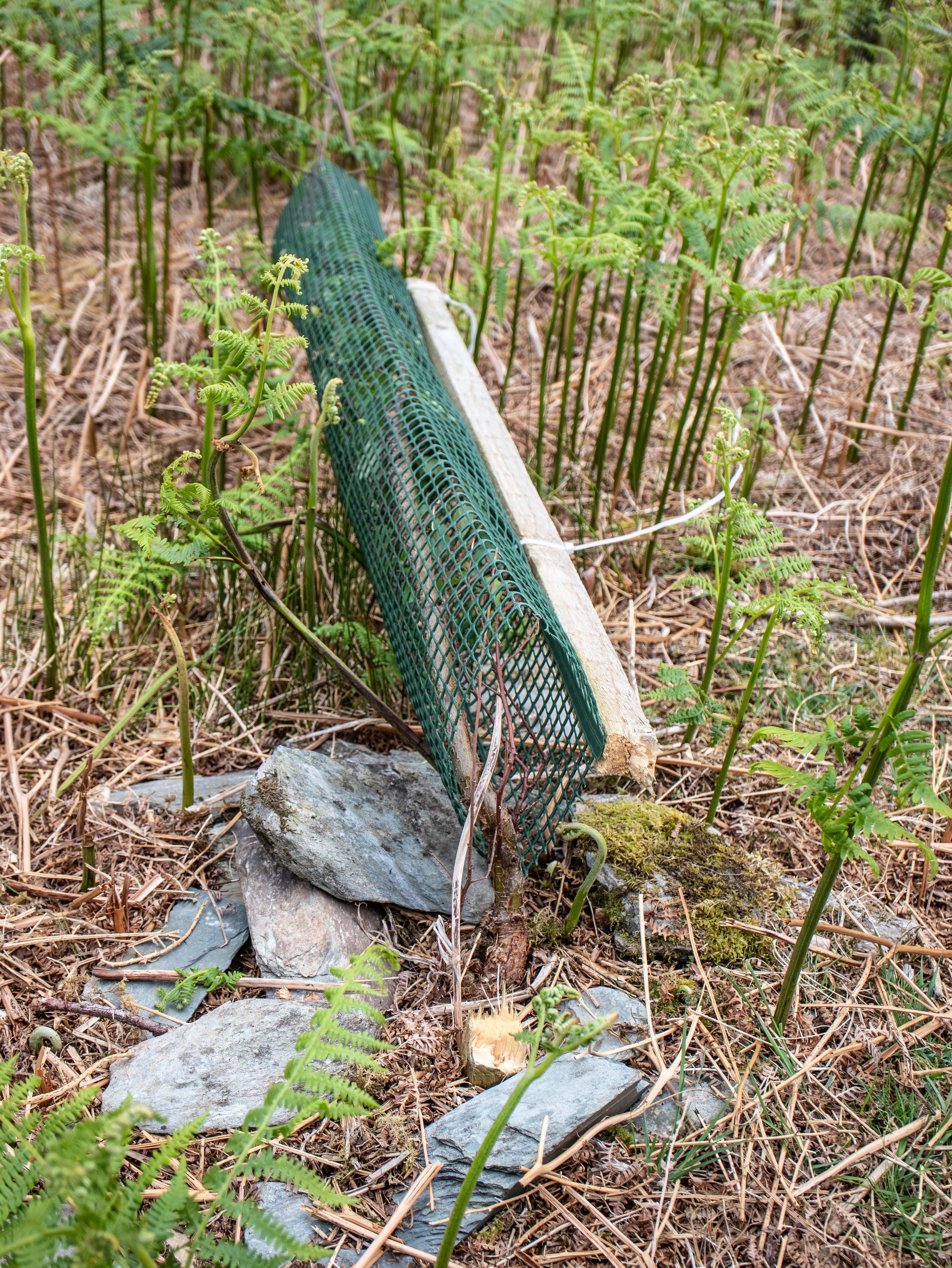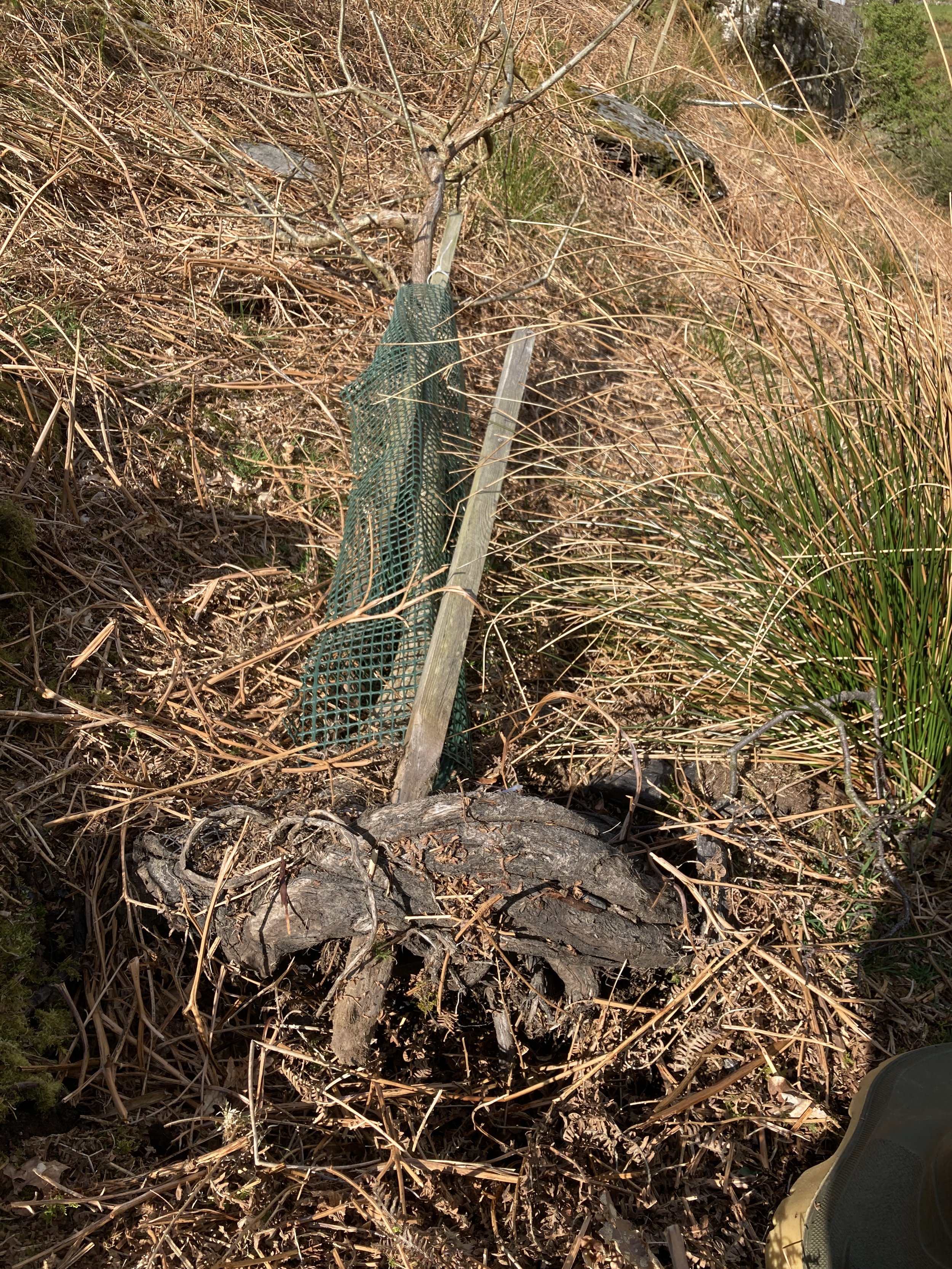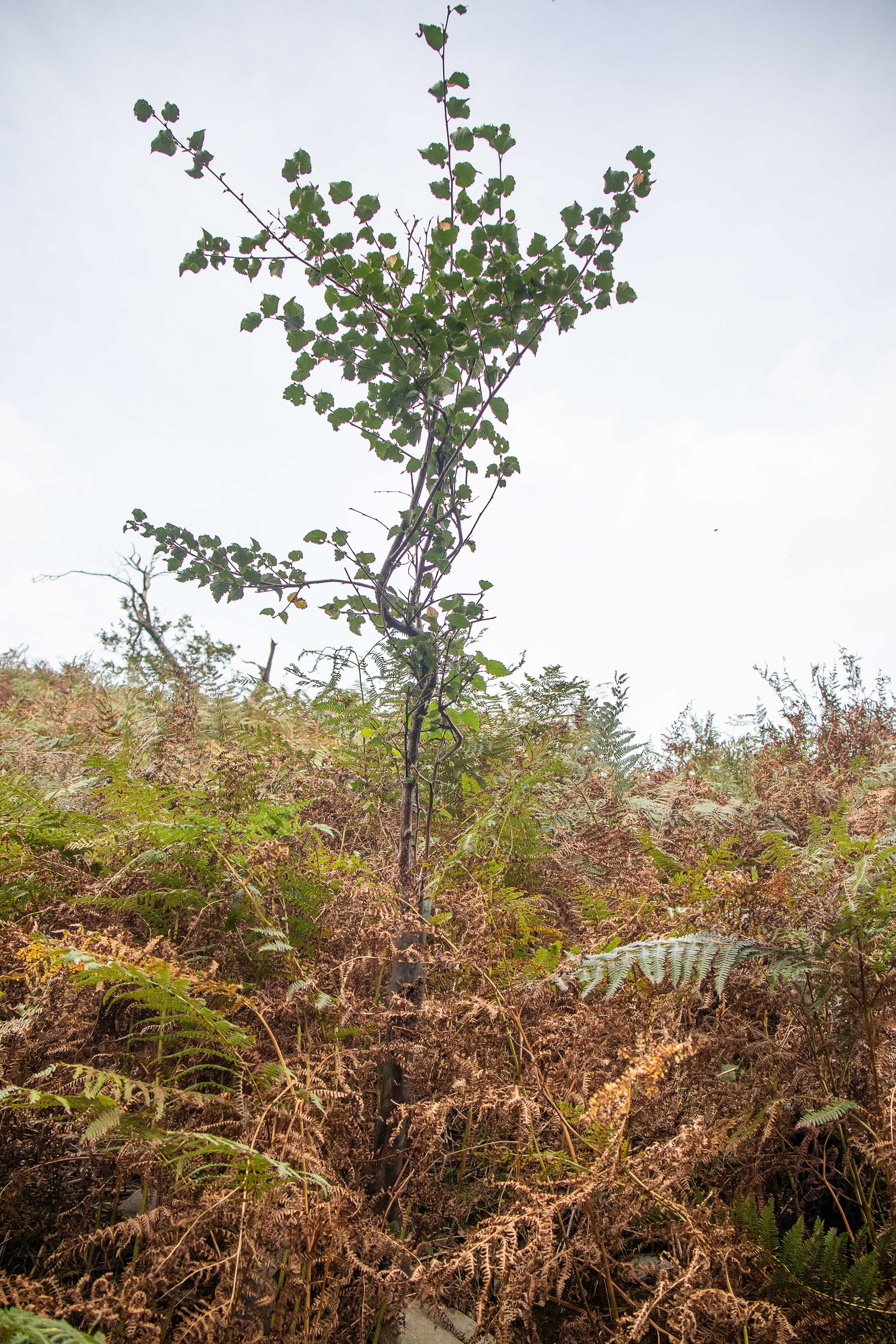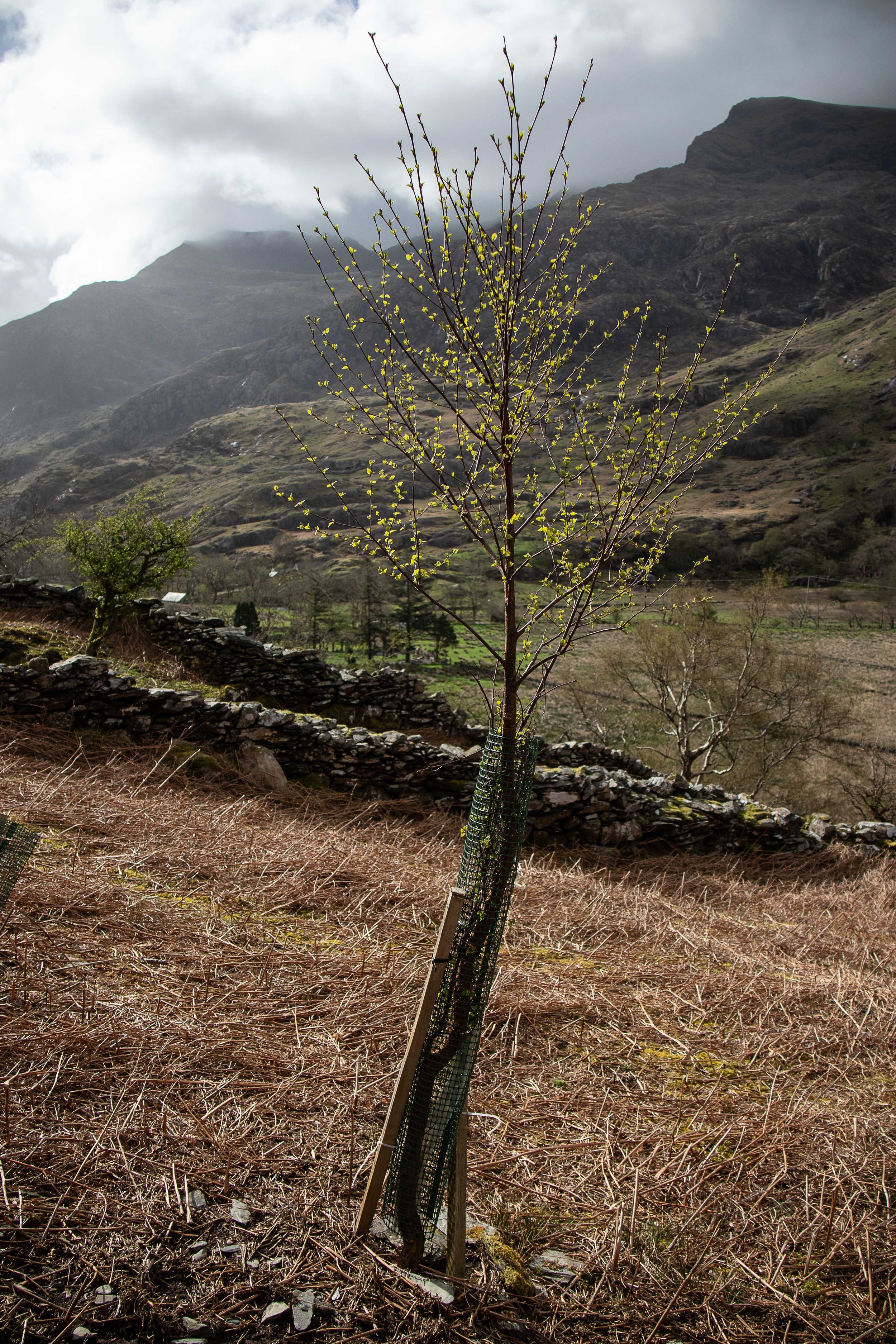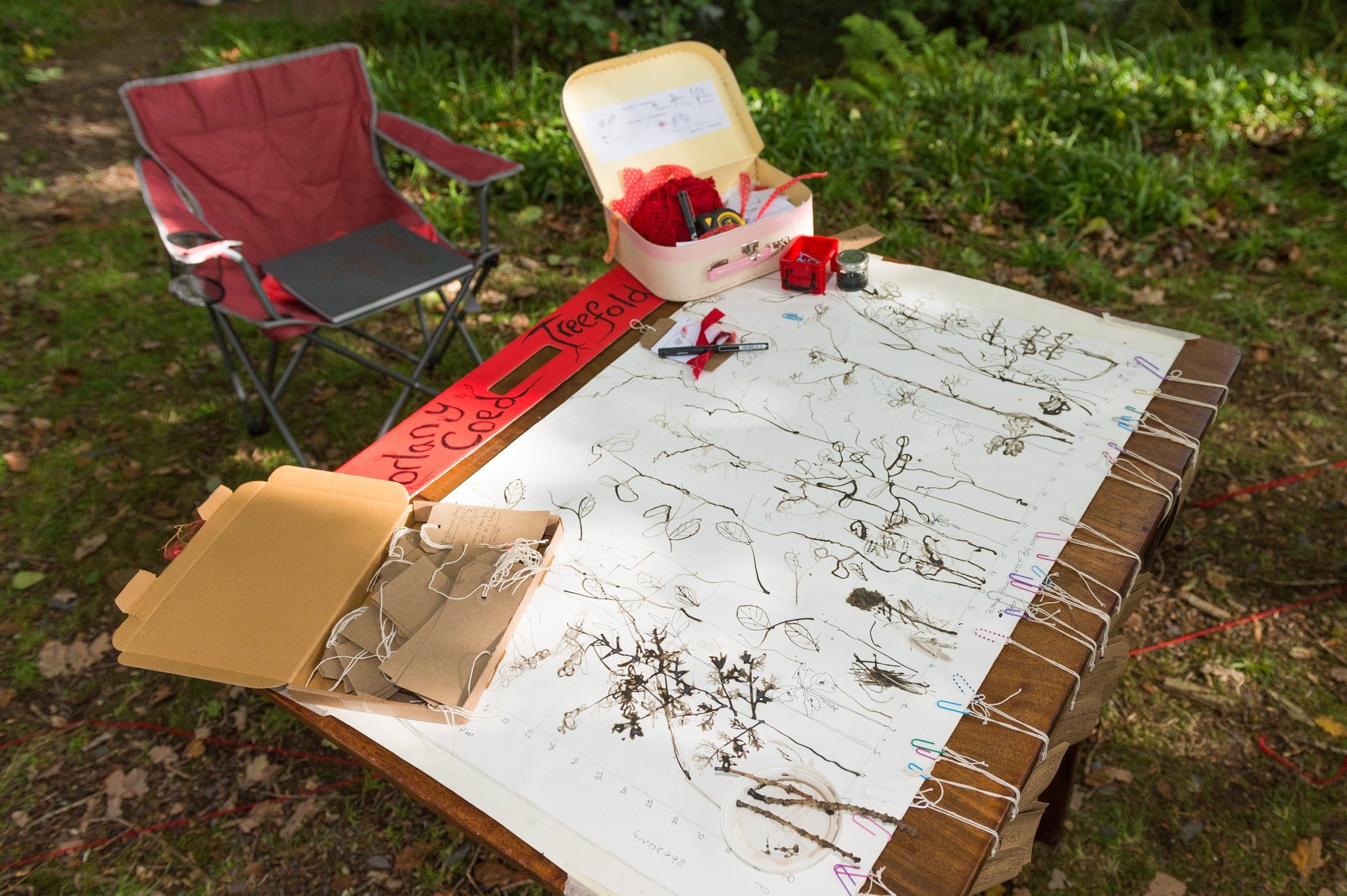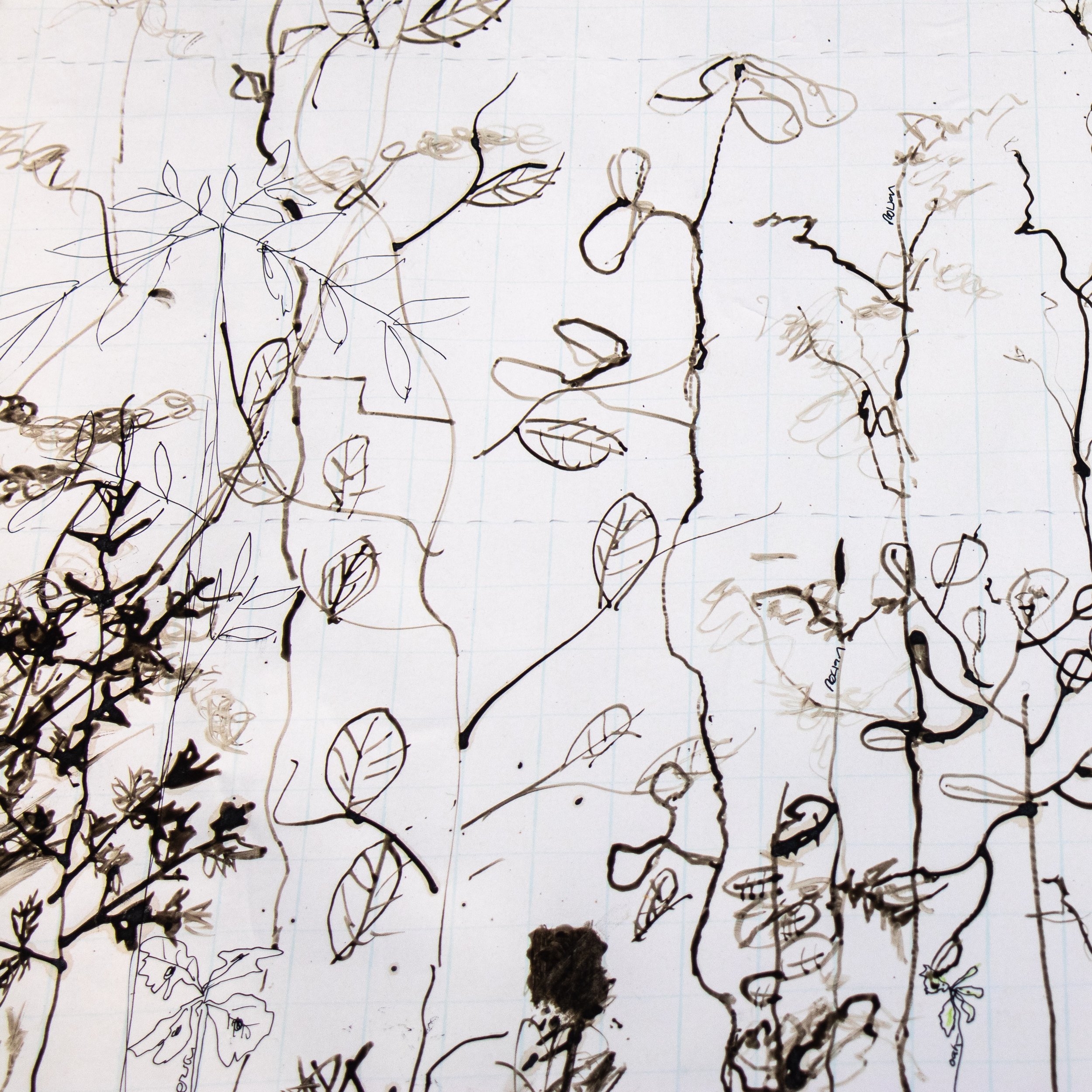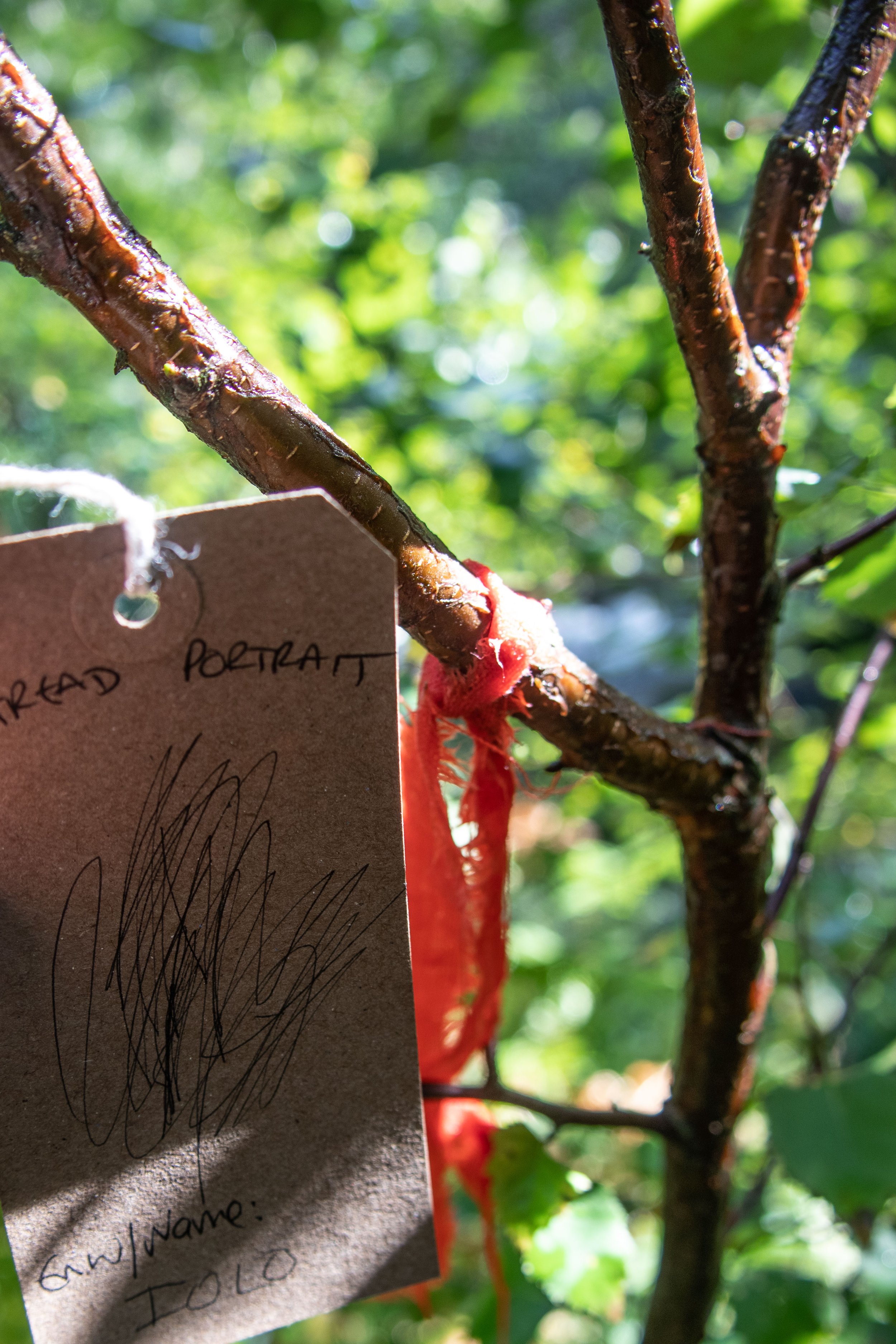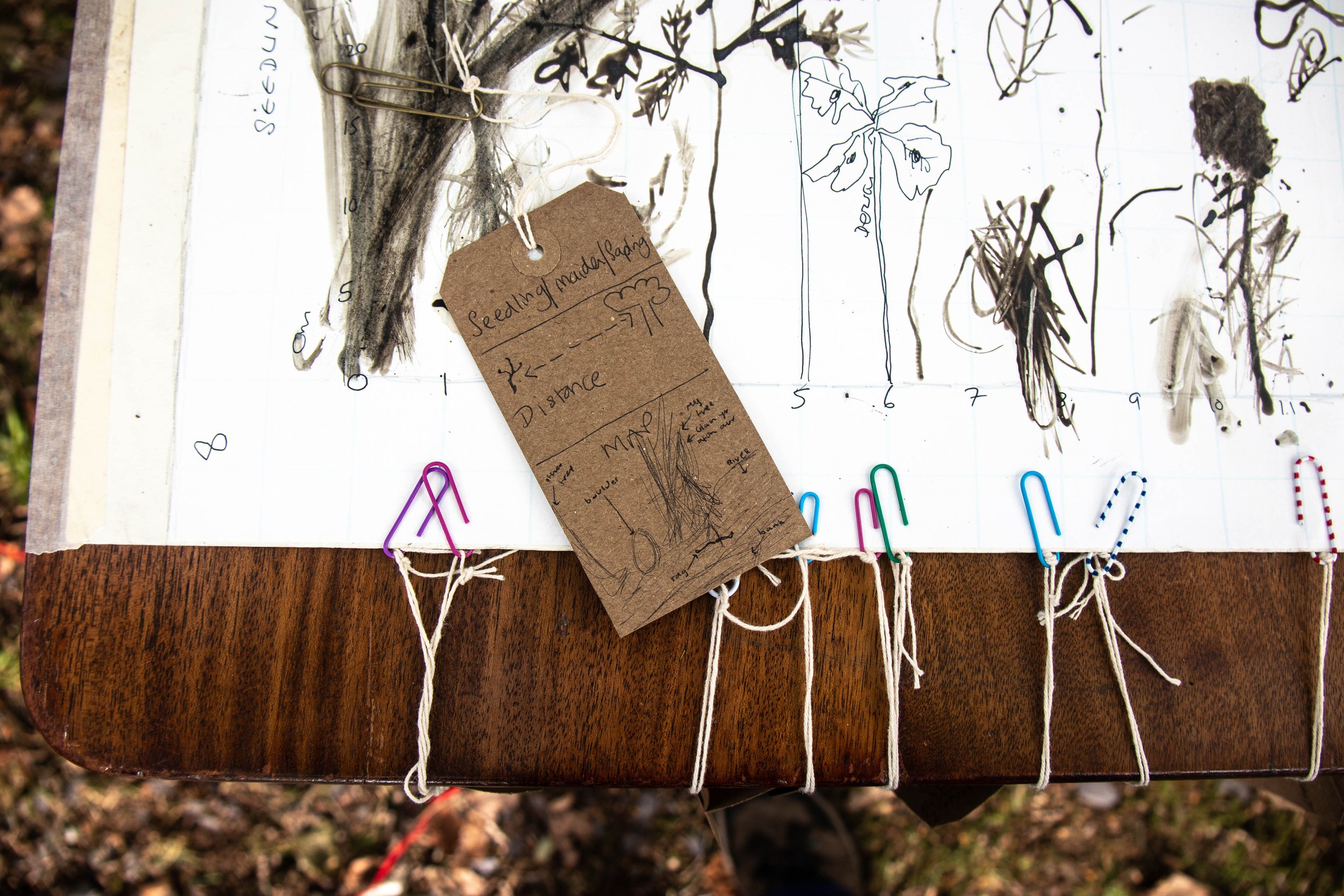Corlan y coed : Treefold
Oak 16, June 2015
Corlan y Coed / Treefold is about finding and ‘protecting’ self-seeded trees within an area that maybe grazed or mown. It offers something of a third way to tree planting/rewilding, and results in scattered tree regeneration, eg on y Ffridd. It is different to planting trees because it requires deep noticing, attention, connection, waiting, uncertainty and working with the parent trees. You have to see where the collaboration leads, rather than being in control. And it is slower (at least initially), it works in tree-time rather than human-time.
And perhaps, if many of us could offer a Corlan Y Coed Treefold service for different patches of land we are committed to, we might be supporting a different kind of regeneration? One that signals a different relationship to the more-than-human world? The potential of radical alliance with plants.
Oak 3, July 2014
introduction
Since 2005, I have been walking my milltir sgwâr - y ffridd - behind my house in Belan, Nant Peris.
Y ffridd is mountain pasture, with scatterings of trees, rocks, bog, streams and grazed here by sheep and goats. As the old trees in our Ffridd die, from old age, gales (and more recently, ash die-back and drought), they are not replacing themselves. No young trees are growing at all, as first pointed out by my neighbour, Dei Tomos. As I got more involved with the details of the land, I started to worry about the ability of my favourite trees to reproduce. But then i started to notice tiny trees - typically 1.5 to 10cm high - trying to grow, soon to disappear before they reached about 12cm tall.
The trees were trying to replace themselves.
Orginal record of the first Corlan y Coed, 2014
Seeking a way to be in radical alliance with the trees and land, in May 2014, I asked the farmer (JM) if i could protect the tree seedlings that I saw along the sheep paths I was walking. He told me that the farm payments he received would not allow 'encroachment' of any shrubs/trees. But that isolated individual trees should be ok, or at least, not noticed (and in his opinion not likely to grow anyway).
So over the last 10 years, i have been working in collaboration - in service - to the trees and land and farmer, protecting nearly 300 seedlings. And just in case it isn't obvious, I have never planted a tree, and sheep (and goats) continue to graze on the land. I have come to think of the work as connecting to some kind of ‘reproductive justice’ for trees, a radical alliance with them which offers an alternative to the (in my opinion potentially colonial) ‘rewilding’ and ‘reforesting/tree planting’ movements. I have written some more about this below.
While attending to their protection, I have somewhat erratically measured and photographed the tiny-trees, trying to witness their lives, and recording what happens. The tallest (a birch - Birch 23), protected in 2014 at 2cm high, has grown to 330cm tall by October 2024 - a young tree! And the tallest oak (pictures right), the same age as Birch 23, was 94cm tall in October 2024.
80+ tree-lets have survived so far. Survival rates are about 34%, with big differences between species: Ash 20%, Birch 25%, Hawthorn 30%, Oak 45%, Holly 46%, Rowan 50%, Hazel 64%.
How do they die? The biggest loss is to being eaten by sheep/goats when my makeshift enclosures get knocked off (54% of trees that die, die like this), or eaten within enclosures (by slugs?) (38%) or dried in drought (5%).
I’ve tried to find out about survival rates for equivalent planted trees, but it’s very hard to find this! Luckily I’ve got a sort of comparison with about 30 trees planted by another farmer on the Ffridd on the other side of the valley in 2018. Of these saplings, planted at about 1.5m (without any protection!), 50% died (eaten or blown over or both) within a year. I protected the 16 that remained in 2019, and the survival rate of those to date is 82%, and the tallest is 360cm.
I have recently coralled the 1000 or so photos into a ‘family album’ which is available to view: some excerpts below.
Newyddion - News!
We have our first ‘mature’ tree! Or at least a teenager. In April 2024, Birch 23 produced catkins! She was standing at 286cm tall and has grown to 313cm tall by October 2024.
Meanwhile, neighbouring Birch 25, which had reached 280cm in Autumn 2023, suffered terribly in a storm Debi in November 23. Her main stem broke at about 60cm high, leaving a single sprout with about 6 buds in April 24.
Tragedy also struck with nearby Birch 32. In April 24, at 257cm, one of her two stems broke. I propped her up but then in January 25 Storm ëowyn (and or goats?) broke her other stem. So I had to cut them off. Similar to Birch 25, she has little sprouts at the base, and a strong stem. So hopefully she’ll recover with time. This time I’m trying with no stake - perhaps the stakes are making the trunks weak?
Here is a map of the 7 areas in which I’ve been protecting little trees
Here are some graphs of how the little trees have been doing, when they were protected, how tall they reached and if they died (the small cross), what caused their demise. As you can see, where they are has an effect (eg trees in Area 1 which has a lower grazing level, mostly die within the enclosure, whereas Area 3 with a higher grazing level die mostly when they lose their enclosure and get eaten by sheep/goats).
Tallest trees in Area 3: Bracken Circle. Mostly birch, October 2021 (above) and April 2024 (below)
what have we learned?
What we have learned in Corlan y Coed Treefold
Over a similar period, two major 'initiatives' - that i think have something colonial about them - have been growing in momentum. The first is the drive to 'reforest' (primarily as an instrumental way to mitigate/'offset' carbon dioxide emissions) through large scale planting. The second is 'rewilding', the removal of livestock and human intervention. Both of these are threatening farming ways of life, and the language and culture associated with it. These approaches are also endangering the patchwork of habitats and diversity that require working with and understanding of the details of the land - a patchwork of solutions, not blanket prescriptions.
So I this Corlan y Coed / TreeFold approach might offer something of a third way - it is about re-attaching ourselves with the details of place. This is about a culture of care, of social, environmental and reproductive justice, of entangling ourselves with complexity, of seeing how we can be of service. For it to work, it requires deep noticing and attention and connection. It is different to planting trees because it requires waiting, uncertainty and working with the parent trees. Seeing where the collaboration leads rather than being in control. And it is slower (at least initially - see below), it works in tree-time rather than human-time.
And perhaps, if many of us could offer a Corlan Y Coed Treefold service for different patches of land we are committed to, we might be supporting a different kind of regeneration? One that signals a different relationship to the more-than-human world? The potential of radical alliance with plants.
With thanks to the farmer (JM) for his tolerance, particularly of my OVER doing tree protections in lockdown in 2020, when he was faced with 2m tall trees in plastic protections, and a plethora of other new protections as I noticed hundreds of tiny self seeded trees in my daily lockdown walks. In struggling to feel like I could do something about the state of the world, I had taken liberties, I had over-staked my claim on this land, perpetrating some of that deeply embedded imperial mindset....
lindsey colbourne (heledd wen) 2023
The resilience of self-seeded trees
The farmer on the other side of the valley planted some trees - oak, blackthorn and rowan - between 60-150cm high in 2018. By the time I’d spotted them in 2019, most had been eaten or flattened by the gales. The remaining sixteen saplings I enclosed and staked and these are now offering a comparison with the self-generated tree-lets in my Treefolds.
The images below illustrate the resilience of self-seeded trees vs planted trees when they get pushed over - the root ball of the planted trees has remained in a ball, and when Oak FF was pushed over (April 2023), it died. Birches 9 and 14 by comparison were repeatedly pushed over but continue to thrive because their roots are firmly planted in the ground.
Goats or sheep?
People talk a lot about sheep vs trees. But I have found that goats are more damaging in many ways - not least because they don’t stop eating trees when they get bigger. Here are some images of Birch 9 suffering goat damage to the bark in February 2025
corlan y coed @ Gwyl Afon Ogwen, September 2023
Celf yn y Coed 23 Medi/September. Corlan y Coed: Treefold. Llun: Nick Pipe
In September 2023, I took the idea of Corlan y Coed to Parc Meurig, Bethesda, as part of Gwyl Afon Ogwen, inviting people to:
“Come and discover the secret life of the woods of the future! We will be going on a hunt for tiny trees, mapping and interconnecting the next generation of the woods … If you go gently and quietly, you may even be invited to adopt your very own tiny tree.
Suitable for all ages”
”Dewch i ddarganfod bywyd cyfrinachol coedwigoedd y dyfodol! Byddwn yn mynd ar helfa am goed bychain, gan fapio a chydgysylltu'r genhedlaeth nesaf o'r coed … Os ewch yn hamddenol ac yn dawel, efallai y cewch wahoddiad hyd yn oed i fabwysiadu eich coeden fach eich hun.
Addas i bob oed”
The response, from people of all ages was wonderful, wandering around until finding a tiny tree that asked to be adopted, tying a red ribbon around them, mapping them, and coming back to draw a portrait in oak-gall ink on graph paper marking the distance to the nearest big tree… The backdrop to our table was the Siarter Y Coed, created as part of Utopias Bach’s Ysgol Arbrofol Dod At Ein Coed - Tree Sense Experimental School.






